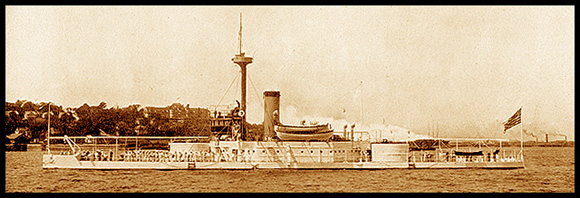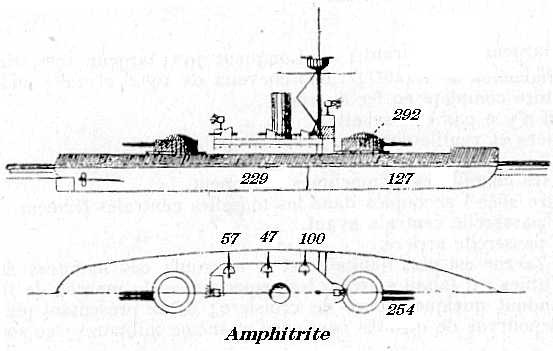


USS AMPHITRITE (BM-2), MONADNOCK (BM-3) and TERROR (BM-4) were monitors, a turreted armored warship, slow and with a very limited cruising range. Previously, another ship that had received the name of TONAWANDA was used as training ship at Annapolis (1866-72) and later renamed as AMPHITRITE (15 May 1869) and officially "rebuilt" as USS AMPHITRITE (BM 2), but in reality she was scrapped and replaced (1874) by a "new" AMPHITRITE, a 3990-ton double-turret monitor. Her construction took two decades, (1874-95). Before the beginning of war against Spain, the USS AMPHITRITE patrolled the U.S. east coast, and served in Caribbean waters during that conflict. After the war she served as a training and station ship and, during First World War I, guarded the Harbor of New York. AMPHITRITE was decommissioned in 1919 and sold in 1920, being converted into a floating hotel. She was scrapped in 1952
BACKGROUND:
The AMPHITRITE was an iron-hulled, twin-screw coastal defense monitor. She was built (1874–1883) in Wilmington, Delaware by Harlan and Hollingsworth and was launched on 7 June 1883. Later she was rebuilt (1890–1894) at Norfolk Navy Yard and commissioned on 23 April 1895, with Capt. William C. Wise in command.
This ship was immediately assigned to the North Atlantic Squadron, visited several eastern seaboard ports and carried out operations out of Hampton Roads and Chesapeake Bay. During these operations, the inadequate ventilation of engine room created havoc among the boilermen. Because of this, several repairs and modifications had to be carried out at Norfolk.
Between November 1895 and January 1898, AMPHITRITE visited several locations such as Annapolis, the York River, Lynnhaven Bay, Norfolk, Charleston, Key West, Port Royal, etc., conducting target practice, serving for naval militia instruction and as a training ship. After leaving Charleston on 1 January 1898, she then returned to Port Royal, remaining there for over three months.
After the explosion, in Havana Harbor, of the battleship MAINE, the United States and Spain moved toward war, and the Navy received the order of being ready for hostilities. AMPHITRITE was at sea when the United States declared war on Spain. On 1 May, AMPHITRITE and her sister ship TERROR departed Key West and joined Sampson’s fleet that was cruising off the coast of Cuba in search of Cervera's squadron. Because monitors could not carry large amounts of coal, AMPHITRITE was towed by a heavier ship, the battleship IOWA.
On the afternoon of the 11th of May, the American ships arrived off San Juan, Puerto Rico,. On the morning of 12 May, AMPHITRITE was assigned to the 1st division, and steamed sixth in column as Sampson's ships stood toward San Juan, at 04.00 a.m., from the northwest at the speed of only 4 knots, due to the low speed of the monitors AMPHITRITE and TERROR.
During the subsequent bombardment of San Juan, AMPHITRITE hurled a total of 99 shells shoreward with her 10 inch, 4 inch, 3 pounder and 6 pounder guns. Toward the end of the action, AMPHITRITE lost the services of half of her main battery, when an armored hose on the exhaust pipe of the after turret burst, disabling it.
After this action, AMPHITRITE returned to Key West, and remained there until May 24th. During the following months, AMPHITRITE operated out of Key West on blockade duty, covering waters off Cape Haitien, Haiti. On 2 August, she shifted to Cape San Juan, Puerto Rico.
At 7:00 PM on 6 August 1898, a party of officers and men under Ensign K. M. Bennett left the ship to reoccupy the lighthouse at Cape San Juan. About an hour before midnight on the 8th, a large Spanish force attacked the lighthouse, but the Americans drove them off. A relief party from AMPHITRITE landed on the morning of the 9th, and 60 women and children were then sent out to the tug LEYDEN. The Americans then closed the lighthouse, left the flag flying, but returned to the ship.
AMPHITRITE departed Cape San Juan on 18 August for Guanica, Puerto Rico, arriving the following day, and lingered there until 31 August, on which day she sailed for Mole St. Nicholas, Haiti. Proceeding thence to Hampton Roads, she arrived there on 20 September. Departing that port six days later, AMPHITRITE moved up to Boston, where she remained from 29 September 1898 to 25 February 1899.
The ship served in the US Navy, (including WW I), until she was decommissioned on 31 May 1919, stricken from the Navy list on 24 July 1919 and sold to A. L. D. Bucksten of Elizabeth City, N.C. on January 1920, and, after being stripped of her turrets and superstructure, AMPHITRITE was towed to Beaufort, S.C., where she was used as a floating hotel. Later, she was towed to Florida for the same purpose. After being chartered by the government in 1943 and towed to Elizabeth City, she was used as lodging facility. AMPHITRITE was sold again in the spring of 1951, and taken to Baltimore where she was sold to the Patapsco Steel Corp., and, by the spring of 1952, AMPHITRITE was scrapped.
ADVANTAGES/DISADVANTAGES:
In spite of her large guns, because of her slow speed, she had minimal military value. The coal bunkers were incapable of carrying a sufficient amount of coal for any long period of cruising. The lack of reserve buoyancy (20% instead of the 80% of a more typical warship) made travel on the open seas somewhat dangerous. By the time of the Spanish American War, monitors were nothing more than floating batteries.

| Classification: | Amphitrite Class Monitor | |
|---|---|---|
| Laid down: | 1874 | |
| Launched: | June 7, 1883 | |
| Commissioned: | April 23, 1895 | |
| Rig: | One military mast | |
| Armament: | Four 10 inch (254 mm) breechloading guns | |
| Two 4 inch (100 mm) rapid fire guns | ||
| Two 6 pounder (57 mm) rapid fire guns | ||
| Two 3 pounder (47 mm) rapid fire guns | ||
| Two 37 mm Hotchkiss guns | ||
| Seven one pounder gun | ||
| One Colt revolving guns | ||
| Contractor: | Harlan and Hollingsworth, Wilmington, Delaware | |
| Length: | 262 feet, 9 inches | |
| Beam: | 55 feet, 10 inches | |
| Draft: | 14 feet, 6 inches | |
| Displacement | 3,990 tons | |
| Complement: | 171 Officers and Enlisted Men | |
| under the command of Char;es J. Barclay | ||
| Engine Type: | Two engines generating 1,600 hp., 2 screws | |
| Speed: | 10.5 knots | |
| Coal endurance | 1800 nautical miles at 10 knots | |
| Normal coal supply: | 250 tons | |
| Armor: | Armor belt - 180 mm, iron. | |
| Conning Tower - 190 mm | ||
| Chimneys and ventilators - 100 mm to height of .9 m | ||
| Deck - 40 mm | ||
|
Turrets - 292 mm (fixed portion) and 190 mm (movable
portion)
|
||
| Double bottom under boilers and engines. | ||
| Cost: | ?? |
Bibliography:
Union Ironclads. http://www.ameritech.net/users/maxdemon/union.htm
Commandant de Balincourt. Les Flottes de Combat en 1908. Libraire Militaire Berger-Levrault & Cie. Paris. 1908.
NORFOLK NAVAL SHIPYARD. USS AMPHITRITE. http://www.nnsy1.navy.mil/History/AMPHITRI.HTM
DEPARTMENT OF THE NAVY -- NAVAL HISTORICAL CENTER. Online Library of Selected Images. Ships of the Spanish-American War— USS Amphitrite. http://www.history.navy.mil/photos/sh-usn/usnsh-a/bm2.htm
“Dictionary of American Naval Fighting Ships,” (1991) Vol. A, p.269. http://www.uss-salem.org/danfs/monitors/amphitri.txt
1898 The Spanish American War in Puerto Rico. http://home.coqui.net/sarrasin/index.htm

